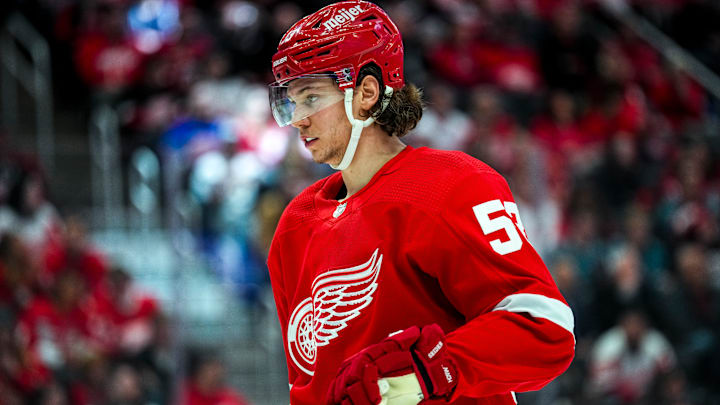Detroit Red Wings may have more help arriving for Moritz Seider in the defense core.
A prospect like Antti Tuomisto may help in the not-so-distant future along with Axel Sandin-Pellikka in the distant future, and players like Shayne Gostisbehere help alleviate some minutes from Seider. However, Seider will likely earn his paycheck playing against the stiffest competition with the highest amount of time on ice. In turn, this means Seider must learn to dictate the game on his terms, not anyone else’s. In my opinion, he’s well on his way. Teams intentionally avoid Seider on the ice whenever possible, as they know he’s one of the most demanding customers. Doing so pressures his defensive partner a bit more than in previous seasons, but it speaks volumes about Seider’s play.
Walman is still a fun, effective player. Throughout the season, he has faced injuries that seemed to hamper his consistency and effectiveness this season. It is completely understandable. As he reaclimates and is able to play regular minutes over the next stretch of games, his overall play should improve. With his injury and illness time, Seider has had different defensive partners. In his career, Seider seems to play his best when he has a consistent defensive partner like Walman or Éric Gélinas, whom he was paired with in Rögle BK of the Swedish Hockey League (SHL). Even more impressively, Seider seems to bring out the best qualities in his consistent defensive partners. Gélinas even earned a contract with the Chicago Wolves of the American Hockey League (AHL), associated at the time with the Carolina Hurricanes, after spending a season paired with Seider.
Although it’s not likely in the future, having a consistent defensive partner like Simon Edvinsson, or a possible candidate in Albert Johansson, William Wallinder, or Shai Buium could help Seider’s overall game and controlling play as teams may not be able to choose a less consistent defensive partner. Having options on the left side is a huge asset, as Seider’s defensive partner seems as important as Edvinsson’s. Remembering when we watched Chiarot and Seider on a defensive pair, I cringe. It was some of the most difficult hockey to watch. So much blame rested on Chiarot’s shoulders, whether right or wrong, I think it’s fair to reflect back and note that blame was shared.
Sometimes, players just don’t have the chemistry or effective communication, even if a defensive pairing looks perfect on paper.
It’s possible this is another opportunity for Seider to learn from, finding ways to work with a defensive partner even if it’s not his preference and adjusting to give the pairing the best chance to succeed.
These opportunities aside, I think Seider is already an NHL star. Seider is incredible regardless of anyone’s advanced analytics or hockey cards. For Red Wings fans, it’s blatantly obvious, but I can see the confusion for any outsider reviewing Seider’s game. It’s difficult to truly appreciate his gifts unless he’s part of your team.
If you get the time, IceHockeyGIFs posted a masterpiece of over 30 minutes that portrays Seider’s journey so far:
Seider’s another reason Red Wings fans are so lucky. We know how special Seider is before the rest of the league catches up if they ever do. (Probably not, given the lack of love for Nicklas Lidström.)
